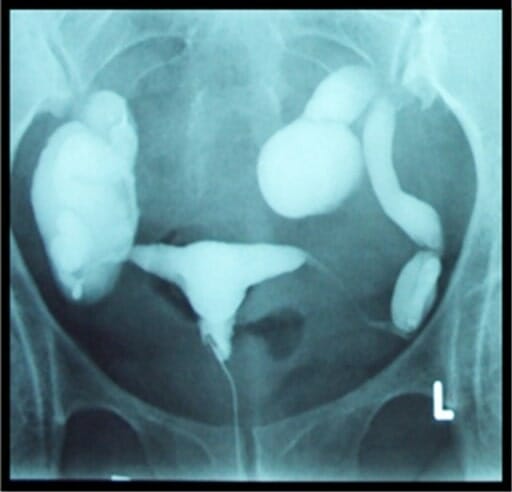Playlist
Show Playlist
Hide Playlist
Pelvic Inflammatory Disease
-
Slides STD Female Repro.pdf
-
Download Lecture Overview
00:01 Our topic now brings us to the convergence point of pelvic inflammatory disease. 00:06 It’s characterized by the following: You want to know these. 00:10 Pelvic pain, adnexal tenderness. 00:12 What’s meant by adnexal tenderness? Adnexa means those organs that are close to or next to what you’re trying to feel or palpate. 00:24 So if you’re down at the pelvic region and you’re referring to the adnexal tenderness, we’re referring to the ovaries. 00:31 Fever and vaginal discharge, part of PID. 00:35 Usual suspects, Chlamydia, trachomatis D through K, Neisseria gonorrhea. 00:41 It can also be polymicrobial with enteric bacteria, usually after an abortion or delivery, look for that. 00:47 And bacteria spreads from the uterus upward via lymphatics or the veins, resulting in PID. 00:56 What are my complications? You may result in peritonitis, intestinal obstruction due to adhesions, why? So you're going to now group together for me -- Earlier, I walked you through ectopic pregnancy and pelvic inflammatory disease. 01:12 Why? Whenever there’s inflammatory process or lesion or whatever, then it’s soon to be followed by repair and collagen and fibrosis, right? Fibrosis in the fallopian tube then predisposes your patient to develop ectopic pregnancy. 01:29 Fibrosis is not good for the intestinal area. 01:34 Bacteremia especially with enteric bacteria and, unfortunately, infertility. 01:41 Serious consequences and complications of PID.
About the Lecture
The lecture Pelvic Inflammatory Disease by Carlo Raj, MD is from the course Sexually Transmitted Diseases (STDs).
Included Quiz Questions
Which group of organisms are all known to cause pelvic inflammatory disease?
- C. trachomatis, N. gonorrhoeae, enteric bacteria
- N. gonorrhoeae, N. meningitidis, T. pallidum
- C. trachomatis, H. ducreyi
- Herpes simplex virus (HSV), Human papillomavirus (HPV), E. coli
- Gardnerella vaginalis, N. gonorrhoeae, Trichomonas vaginalis
How does PID lead to infertility and ectopic pregnancy?
- PID can cause scarring and fibrosis in the fallopian tubes, leading to occlusion.
- PID can cause adhesions in the uterine cavity.
- PID can cause ovarian failure.
- PID can cause destruction of follicles in the ovary.
- PID can cause persistent inflammation impeding implantation.
Customer reviews
5,0 of 5 stars
| 5 Stars |
|
5 |
| 4 Stars |
|
0 |
| 3 Stars |
|
0 |
| 2 Stars |
|
0 |
| 1 Star |
|
0 |






